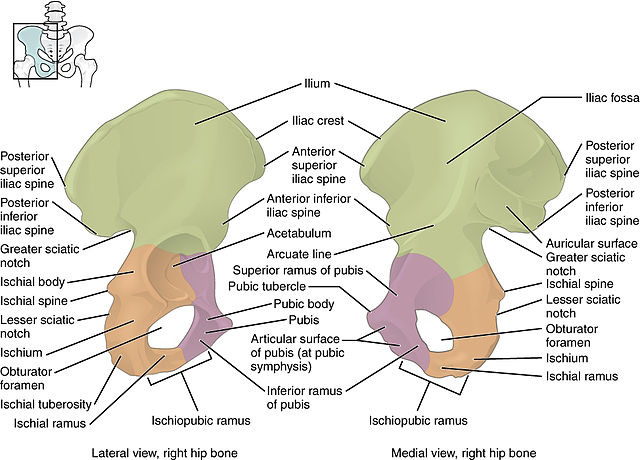It is a irregular bone present in the hip region of the body which is expanded above and below but constricted in the middle.
Articulations - Hip joint and pubic symphysis.
There are three parts of hip bone named ilium which is present superiorly, ischium present posteroinferiorly and at last pubis which is present antero inferiorly.
ANATOMICAL POSITION
1. Pubis should faces forewards and medially above obturator foramen.
2. pubic tubercle and anterior iliac spne in same plane.
3. symphyseal surface of pubis lies medially.
4. ilium is expanded and projects upwards.
SIDE DETERMINATION
1. Acetabulum lies laterally and ilium lies above acetabulum.
2. Direction of acetabulm will determine the side.
ILIUM
~ Upper part of hip bone.
~ 2/5th part of acetabulum is formed by ilium.
~ Flat and expanded portion above acetabulum cavity.
~ Upper end expanded and known as iliac crest.
~ Lower end is smaller and fused with pubis and ischium and has iliac tuberosity.
~ Three borders named anterior, posterior and medial border is present in ilium.
~ Along with three borders, three surfaces are also present known as gluteal, iliac fossa and sacropelvic.
Note :- Sacropelvic surface has iliac tuberosity.
ATTACHMENTS
1. MUSCLES
a. Sartorius
b. Fascia lata
c. Tensor fascia lata
d. External oblique abdominis (insertion).
e. Lattisimus dorsi
f. Transversus abdominis
g. Quadratus lamborum
h. Lumbar fascia
i. Internal oblique abdominis
j. Gluteal maximus
k. Erector spinae
l. Piriformis
m. Psoas minor (insertion)
n. Gluteal medius
o. Gluteal minimus
p. Rectus femoris
q. Iliacus
r. Pre auricular sulcus
s. Obturator internus
2. LIGAMENTS
a. Inguinal ligament
b. Dorsal sacro iliac ligament
c. Ilio femoral ligament
d. Sacro tuberous ligament
e. Ventral sacro iliac ligament
f. Ilio lumbar ligament
g. Interosseous sacro iliac ligament
CAPSULE
a. Articular capsule of hip joint
ISCHIUM
Forms the lower and posterior part of hip bone and contribute to form a posterior 2/5th of the articular surface of acetabulum.
Parts -
1. Body.
~ Has two ends which is upper and lower end.
~ Has three surfaces known as femoral, dorsal and pelvic surfaces
~ Has three borders anterior, lateral and posterior borders
Note - Dorsal surface gas ischial tuberosity and posterior border has ischial spine and lesser sciatic notch.
2. Ramus of ischium.
a. Two borders named upper and lower borders.
b. Two surfaces named anterior and posterior surfaces.
Note - Posterior surface js divided into pelvix and perineal area.
ATTACHMENTS
A. MUSCLES
1. Obturator externus
2. Quadratus femoris
3. Semi membranosus
4. Biceps femoris
5. Semi tendinosus
6. Adductor magnus
7. Obturator internus
8. Levator ani
9. Coccygeus
10. Gemellus superior
11. Gemellus inferior
12. Obturator membrane
13. Fascia lata
14. Membranous layer of superficial fascia of perineum.
15. Gracilis
16. Adductor brevis
17. Adductor magnus
18. Obturator externus
19. Sphincter urethra
20. Transverse perinei profundus
21. Ischiocavernosus
22. Transverse perinei superficial
B. LIGAMENTS
1. Sacrospinous
PUBIS
~ Forms anterior part of hip bone and articulates with the opposite bone forming a secondary cartilagenous joint called pubic symphysis.
~ Forms upper and anterior 1/5th of articular surface of acetabulum.
PARTS -
1. Body -
a. Three surfaces -
Anterior, posterior/pelvic and symphyseal.
b. One border -
Pubic crest
Note - Pubic tubercle is present in pubic crest.
2. Superior ramus
a. Three surfaces -
Pectineal, pelvic and obturator surface
b. Three borders -
Obturator crest, pectineal line and inferior border
3. Inferior ramus
a. Two surface -
Anterior and posterior
b. Two borders -
Medial and lateral
ATTACHMENTS
A. Muscles
1. Adductor longus
2. Gracilis
3. Adductor brevis
4. Obturator externus
5. Levator ani
6. Pelvic fascia
7. Obturator internus
8. Cremaster
9. Rectus fascia sheath
10. Rectus abdominis
11. Pyramidalis
12. Conjoined tendon (tendon)
13. Fascia tranversalis
14. Iliacus
15. Pectineal fascia
16. Pectineus
17. Adductor magnus
18. Fascia lata
19. Fascia of colle's
20. Obturator membrane
21. Urogenital diaphragm
22. Perineal membrane
23. Sphincter urethrae
B. Ligaments
1. Anterior pubic ligament.
2. Medial pubi prostatic ligament.
3. Inguinal ligament
4. Pubo femoral ligament.
5. Lacunar ligament.
6. Perineal ligament.
CLINICAL ANATOMY
1. Iliac crest is used for taking bone marrow biopsy in anaemia or
leukaemia cases.
2. Weaver's bottom -
Person sitting for a long period of time may get inflammation of their iscial tuberosity.
RELATIONS
1. Obturator nerve.
2. Medial and lateral circumflex femoral arteries.
3. Obturator artery.







